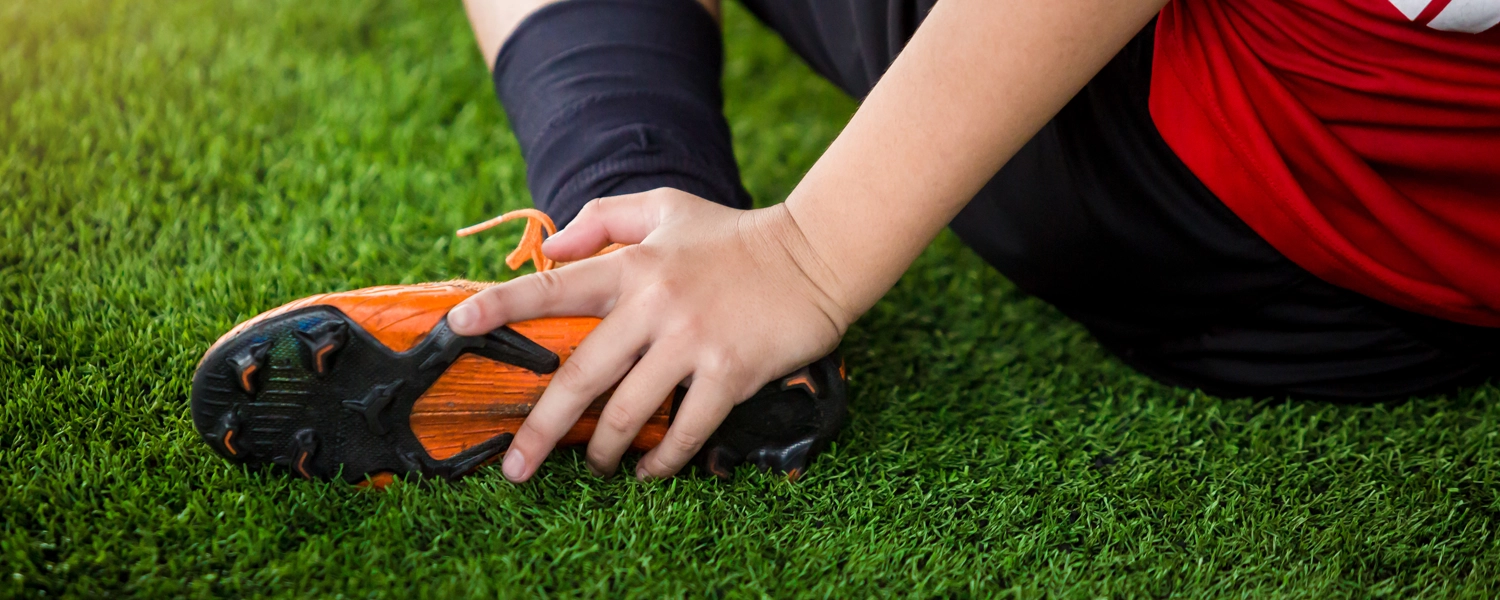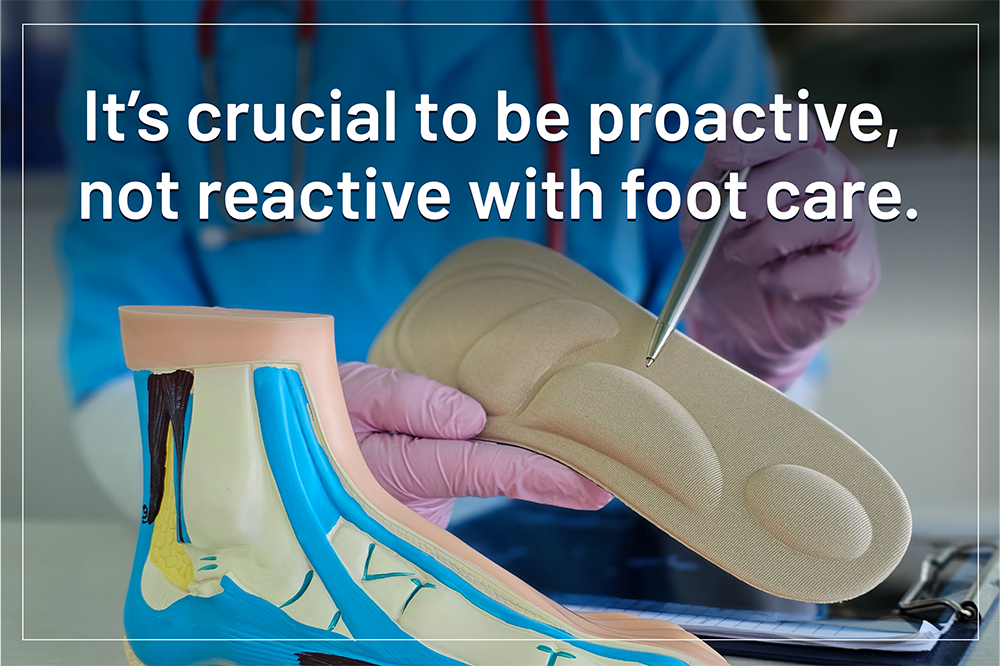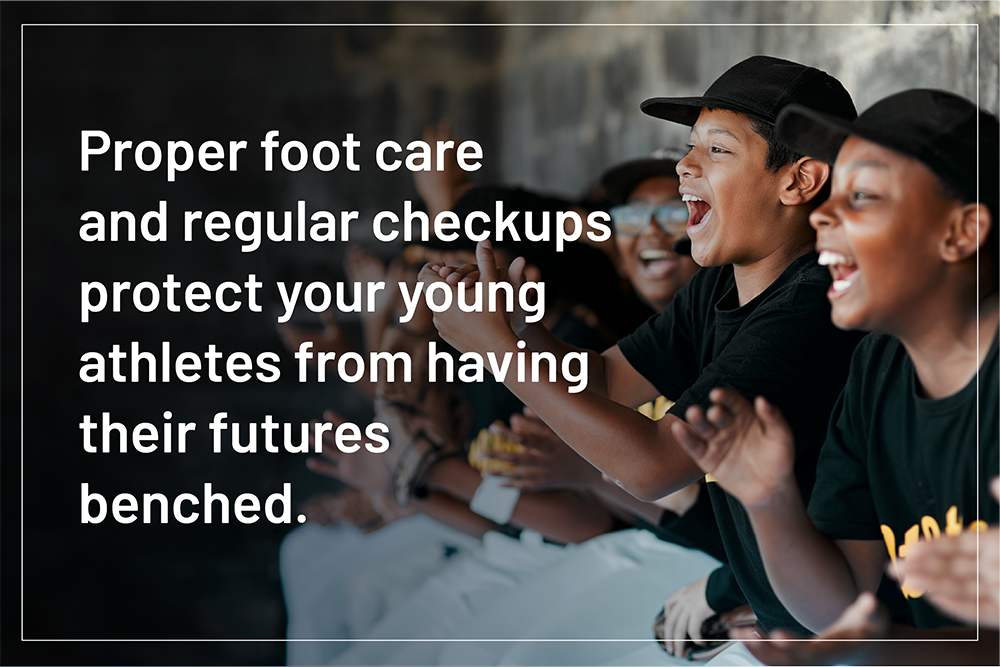Your Student Athletes: Are they ready to hit the field with strong feet?

As school and sports prep begin, there’s one overlooked MVP that every student athlete needs to focus on: their feet and their shoe gear.
From cleats on the soccer field to sneakers on the basketball court, foot health is the foundation of top performance and long-term well‑being. Let’s dive in to see why this care is so important!
Why foot care matters and what the research says:
- Growth plate and overuse injuries without early care
A podiatry-led study involving 80 adolescents found that 36 developed secondary foot injuries. After delaying treatment for growth plate issues, the adolescents developed plantar fasciitis, Achilles tendonitis, and posterior tibial tendonitis. The most common growth plate injury was Sever’s disease, a temporary but painful problem in the heel. Night splints were key in recovery, highlighting the importance of early detection.1 - Chronic ankle instability (CAI) post-sprain
Among over 1,000 adolescent athletes (average age ~15.6), 20% had CAI, which negatively influenced ankle function and quality of life. The study emphasized the need for prevention strategies “as soon as sport participation begins.”2 - Long-term ankle pain and reduced function
Sports-related injuries – especially ankle injuries – are highly prevalent among adolescent athletes, with reported rates ranging from 34.1% to 65%. The findings showed the substantial physical toll sports can have on young athletes and underscore the need for better prevention and injury management strategies.3

Watch for these Top 5 signs there is a foot issue:
- Persistent Achilles or heel pain, especially first thing in the morning
- Swelling, stiffness, or a limp during or after any sports activity
- Tight arches or flat feet which often lead to shin or knee pain
- Frequent ankle “rolling” or feeling wobbly are signs of instability
- Blisters, rash, or athlete’s foot, a fungal infection that thrives in sweaty gear
If any of these signs show up, don’t shrug it off. Go get them checked out at an Upperline Health clinic as soon as possible!
Why proper checkups with Upperline Health board-certified podiatric physicians matter:
- Expert diagnosis: Not all foot pain is the same. Bunions, plantar fasciitis, growth plate injuries, tendonitis all need different treatments.
- Customized care: From orthotics, specialty shoes, to rehab, an Upperline podiatric physician tailors solutions to your student’s body for the sports they play.
- Prevent long-term damage: Untreated issues can lead to chronic pain, instability, or even career-ending problems. Get your child’s feet checked out early.
- Gait & balance evaluation: Catching misalignment early means better performance and fewer injuries over your student’s athletic journey.
School-required physical checkups should include your feet
A physical exam at the start of the sports season can screen for hidden red flags like abnormal gait, misaligned arches, ankle weakness, or press-on toenails. Getting ahead prevents any setbacks later.
Shoes & insoles: Your secret weapons
Selecting the right footwear and foot support is a game-changing across all sports:
- Soccer & Baseball: Wear cleats with sturdy ankle support with orthotic insoles to enhance traction and reduce slippage.
- Football: Fast growth + heavy impact = stress fractures, plantar fasciitis, chronically unstable ankles. Repeated pounding on cleats without support can impact foot development. Getting fitted for specialized insoles and doing strength work around the arch can help control forces.
- Running Track: Your athletes should run in cushioned shoes with good arch support and shock-absorbing insoles. This limits impact stresses.
- Cheerleading & Dance: Hormonal and biomechanical differences make feet vulnerable during puberty. Look for flexible yet supportive shoes with insoles that balance forefoot motion which are crucial in preventing bunions and stress injuries.
- Gymnastics: Impact from stunting and tumbling can stress growing bones. Supportive footwear, orthotics, and strength training help mitigate growth plate stress when not performing.

Quick tips for shoe and insole management:
- Get fitted properly—often!
As you know, your kids’ feet grow fast. Get their feet and shoes professionally measured every few months.
- Rotate their sports footwear
Alternate shoes—cleats one day, sneakers the next—to help sweat evaporation and reduce fungal growth and wear and tear on the footwear. Or buy two pair.
- Insoles are not just for pain
Even without current problems, custom orthotics can boost posture, alignment, comfort, and performance for your student athlete. Get them fitted soon.
Key Takeaways:
- Research backs you up: Early foot issues like ankle sprains, tendonitis, or growth plate injuries can hurt your kids for years if untreated.
- 5 red flags: Heel pain, swelling, arch issues, ankle wobble, and rashes.
- Podiatric physicians & pre-sports checkups: Essential for diagnosing, treating, and preventing foot problems.
- Shoes & insoles = power tools: Key to support, reduce injury risk, and enhance overall performance.
- High impact sports: Cheerleading, football, dance—they all need extra foot TLC during growth spurts.
- Upperline tips: Fitting, rotating gear, insoles, daily checks, early care.
Your next step for your student athlete:
- Book a podiatric physician appointment for a preseason foot check and gait screen.
- Reassess their shoes. Are they the right size? Worn out? Sport-appropriate?
- Invest in quality insoles to support their arches and align gait.
- Adopt a foot care routine. Wash, dry, and stretch daily.
- Listen to their body because pain is a signal. Don’t play through it. Get it treated.
Healthy feet power their performance
Don’t sideline your child with preventable foot issues. Stay proactive, stay supported so their feet carry them all season strong. Whether they’re scoring goals, nailing a dance routine, or cheering from the top of the pyramid, healthy feet = peak performance and happier, longer game days.
All of us at Upperline Health wishes your child a safe, strong, and epic season back at school!

About the Author
Dr. Pamela Jensen-Stanley is a graduate from the College of Podiatric Medicine and Surgery in Des Moines, Iowa. She completed her primary podiatric and surgical residency training at the prestigious University of Texas in San Antonio, Texas with an emphasis in diabetes and diabetic wound care and is published on numerous diabetic and wound care-related topics.
Dr. Jensen-Stanley is active in Somerset Rotary and the American Cancer Society and is a lifetime member of Alpha Phi Omega, an International Co-ed Community Service Fraternity.
Dr. Jensen-Stanley is available for appointments at the following locations:
Upperline Health – Somerset
117 Tradepark Dr
Suite B
Somerset, Kentucky 42503
Upperline Health – Russell Springs
2868 S. US Hwy 127
Russell Springs, Kentucky 42642
References
- Kashanian, Alona, DPM; Eric Feit, DPM, FACFAS; and Jonah Feit. “Treating Overuse Injuries in Adolescent Athletes.” Podiatry Today, January 2015. HMP Global Learning Network.
- Donovan, L., S. Hetzel, C. R. Laufenberg, and T. A. McGuine. “Prevalence and Impact of Chronic Ankle Instability in Adolescent Athletes.” Orthopaedic Journal of Sports Medicine 8, no. 2 (2020): 2325967119900962. https://doi.org/10.1177/2325967119900962. PubMed Central, PMC7029541.
- Al-Qahtani, Mohammed A., Mansoor A. Allajhar, Ahmed A. Alzahrani, Mohammad A. Asiri, Abdulaziz F. Alsalem, Salha A. Alshahrani, and Naif M. Alqahtani. “Sports-Related Injuries in Adolescent Athletes: A Systematic Review.” Cureus 15, no. 11 (November 25 2023): e49392. https://doi.org/10.7759/cureus.49392. PubMed Central, PMC10749669.




